How To Add Cleats To Bike Shoes
There are two basic things to sort out when it comes to setting upwardly cleats on your cycling shoes - the angle of the cleat on the sole of your shoe and the fore-aft position of the cleat.
Finding the correct angle is your first job whether you're just starting out with your start pair of clipless pedals or you're an experienced rider setting up a new pair of shoes and pedals.
>>> Saddle height: how to get it correct, and why it's so important
Badly angled cleats can cause knee pain if not rectified - but a few adjustments to the first angle yous endeavor are usually all you need to notice one that works for you. Bear in mind your cleat angle might non be the aforementioned (in mirror image) for both feet.
>>> Best cheap route bikes
The other chore is the cleat'south fore-aft location. This is less obviously critical to condolement and staying hurting and injury costless, so information technology quite often doesn't become the same amount of attention.
Looking for an consequence? Check out the sportives run past our sister company, UK Cycling Events - in that location's rides all over the land, with a wide range of distance on offering. See the calendar here.
How to fix your cleats: stride-past-pace guide
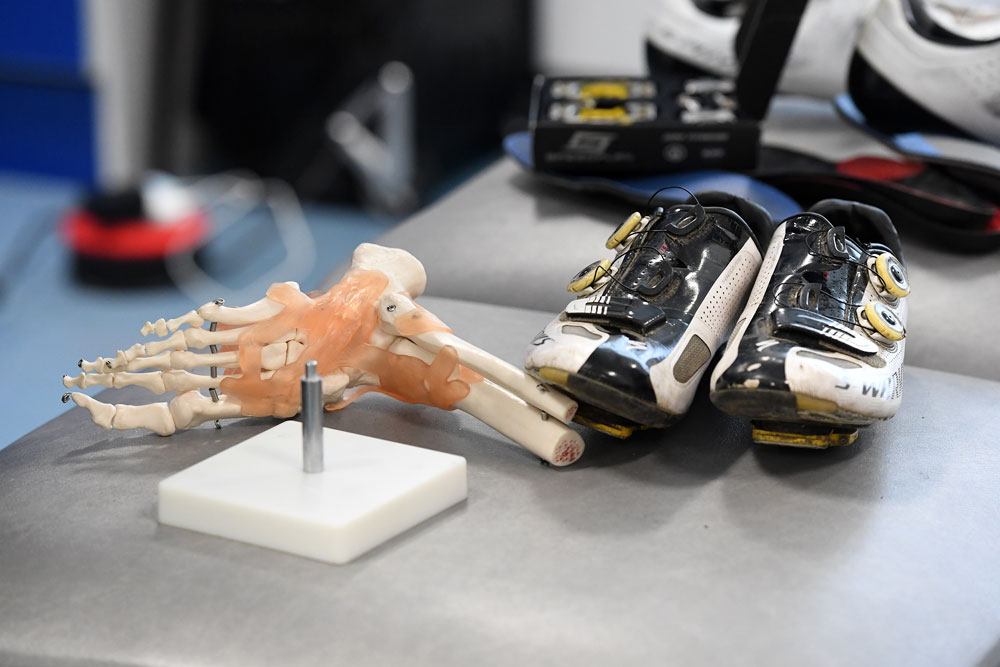
Information technology is generally accustomed that positioning the cleats so that the eye of the pedal axle will be in line with the brawl of your human foot is biomechanically the optimum for pedalling efficiency and power transfer.
In order to make sure this is the case, with your shoe and pedal combination follow these simple steps.
Get-go with cleats removed from the shoe
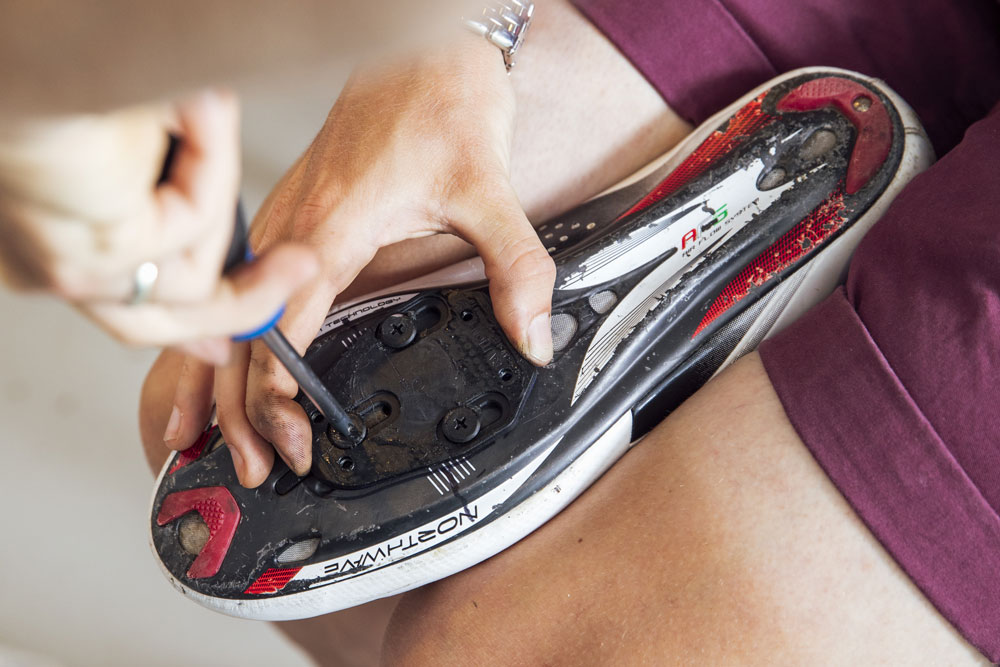
At this indicate perhaps information technology is besides an opportunity to remember about plumbing fixtures some new cleats too, every bit they are cheap to replace and vesture down relatively easily
Put your shoes on and locate the ball of your foot
Make certain you're wearing your normal cycling socks. Put your shoe on, and tighten as normal. Feel, by pressing with your thumb or finger, along the inside edge of the shoe to locate the ball of your foot. This should be fairly piece of cake to locate, as information technology is the bony knuckle protruding sideways at the bottom of your big toe.
Marking the brawl of your pes
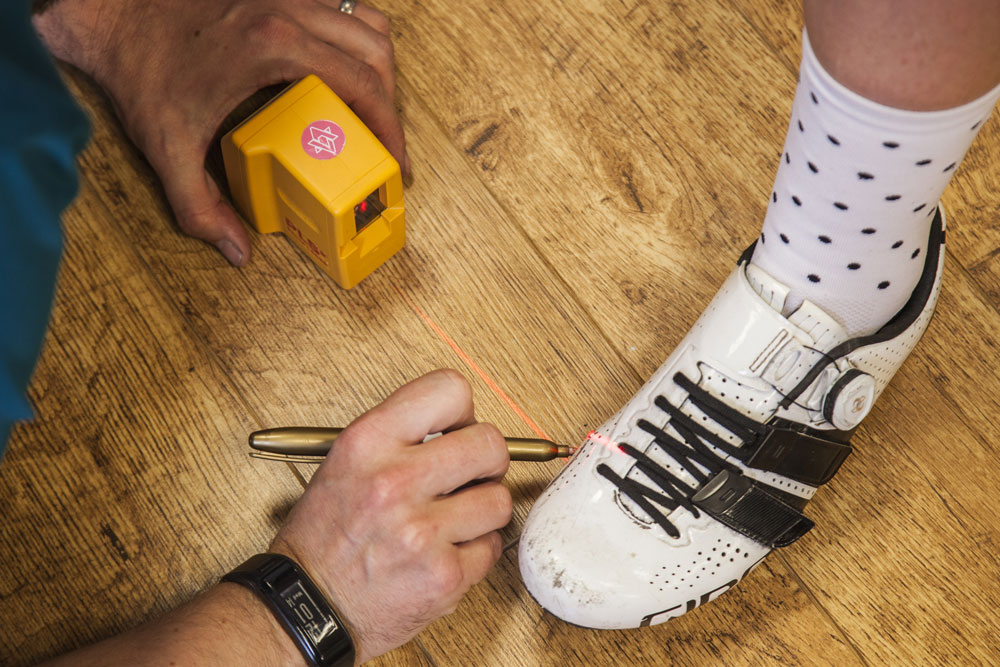
Mark the side of the shoe at the centre point of the ball as accurately as possible. Get someone else to help find information technology if necessary. Repeat all of this for the other foot.
Mark a line along the sole
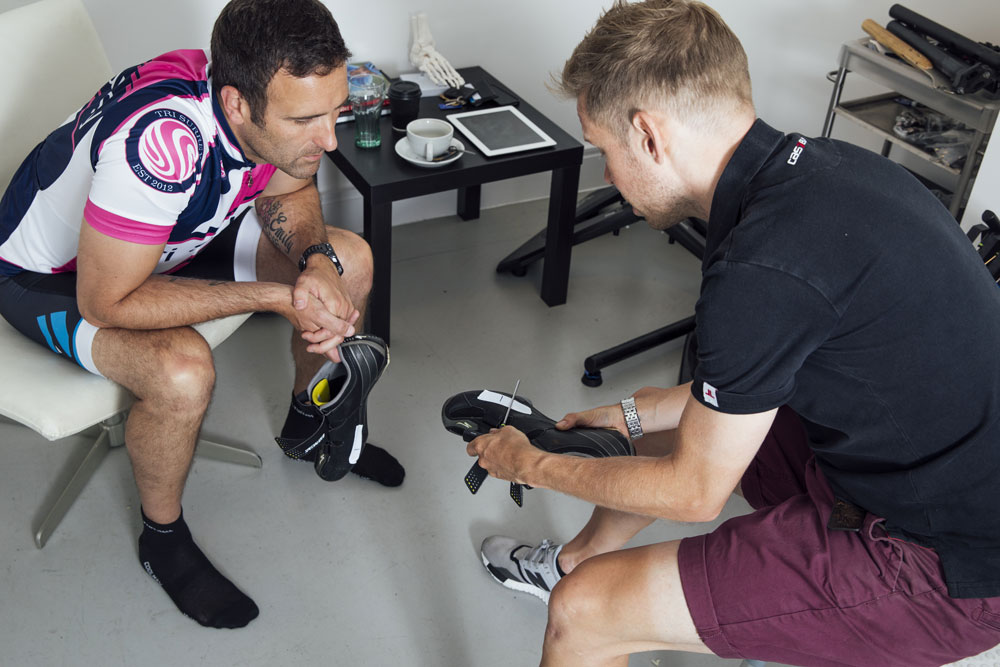
Accept the shoes off, and place them on a flat, level surface. Hold a straight edge against the mark on the shoe, and transfer the line straight down to the aforementioned point on the sole. Turn the shoe over and brand certain that your marking is visible on the sole.
Line the ink upwardly with the marking on the edge of the cleats

Fit cleat, loosely, aligning your marking with the bespeak on the cleat where the eye of the pedal beam will be, once y'all are clipped in. Most cleats provide a mark on the side, past way of a notch or line to indicate the center of the pedal axle, so it is merely a case of lining up your mark with theirs.
Cleats: setting up the fore and aft
Motion the cleat side-to-side to influence how close the human foot sits to the center-line of the bike. If you ride with your knees wide at the top of the pedal stroke, move your cleats inwards to move the pes outwards. If you ride with knees narrow at the top of the stroke, movement the cleats towards the outside of the shoe and the foot in.
Float and tension - what are they, and so?
Tension is simply how easy it is to get in and out of your pedals. Most take some grade of adjuster screw that allows the user to decide how tightly clipped-in they want to be. Initially we'd advise going for the lightest setting simply it's worth bearing in mind that once it becomes second nature to prune in and out, more tension will be only equally easy to use, and much more secure, too.
Colour-coded cleats
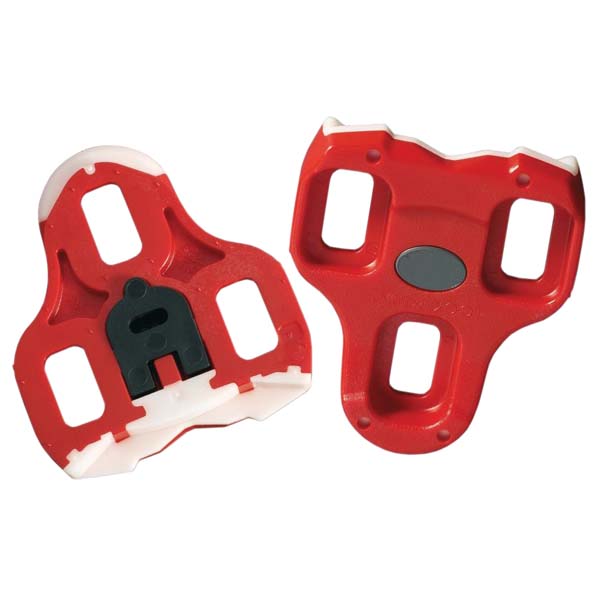
Cleats come in different colours representing different amount of float - gear up your cleats with the right version for you
The amount of float is dictated by fitting different cleats to accommodate. Look offers three cleats: black is fixed, grey* gives four.5° and red gives ix°. Shimano's cherry cleats are fixed and the yellow* ones requite half dozen°.
While many pro racers prefer a super-accurate set-up and minimal float, even they can go it incorrect - rumours propose the knee injury that in one case forced Sir Bradley Wiggins out of the Tour de France may take been caused by an incorrectly aligned cleat.
* These are supplied equally standard with the pedals from each manufacturer
Cleat gear up in more detail: what, why and how
Looking for more than than the basics of how to ready your cleats for the first time? Read on for more than details most where these recommendations come from, and how they tin can contribute to the perfect pedals stroke...
Heel drib and cycling cleat set up
When setting upwards cleats, about cycle fitters' advice is only to identify the heart of the cleat under the ball of the foot. This corresponds nicely with where trained cyclists tend to position their feet when they're riding on flat pedals; it ways that plantarflexion, or pushing downwards the forefoot during the downstroke, tin contribute to a 'rounder' pedalling action that produces power over a greater part of the pedalling circumvolve.
It does non, however, ensure that this is what actually happens. There is evidence that in many cases it does not happen at all and that any useful plantarflexion is more imagined than existent; the ankle remains nearly immobile and the lower leg muscles piece of work mainly to stabilise the ankle.
If the muscles of the lower leg are doing aught more stabilising the talocrural joint, then you may wonder why they are being asked to work at all.
If the ankle is held immobile throughout the pedal stroke, the foot can contribute nothing to the pedalling action - although that didn't seem to impede Jacques Anquetil, the first man to win the Tour de France five times and who famously pedalled with locked ankles in a distinctive toe-down manner.
In fact, it is rare that the ankle is held perfectly rigid and y'all can see 'ankling' in near cyclists, even though it might non be the sort that is most effective.
Much more mutual is the tendency for the heel to drib during the downstroke in a motion that is the exact opposite of the ankling activeness beloved of early cycling writers. And so the excessive plantarflexion of the classic ankling technique may exist a myth and not even desirable, just heel drop is widespread among serious cyclists.
Why heel drib happens varies: some people may simply detect pedalling feels 'easier', since dropping the heel through the downstroke reduces the sensation of resistance in the pedals; others actually may non be able to generate the lower leg muscle force required for foot plantarflexion and therefore unconsciously drib their heel as they button against the pedals. A third reason is saddle height; as well low, and the passenger may drib the heel in an endeavor to find a more than efficient leg extension.
The underlying problem in the middle case is the work required of the calf muscles. Think of the foot as a lever with the ankle as the fulcrum and the heel and ball of the foot as the opposing lever arm ends. The calf muscles pull on the heel via the Achilles tendon to push down the forefoot. The further away from the talocrural joint the bespeak of awarding of downward force by the ball of the foot, the harder the calf muscles must pull on the Achilles tendon.
>>> Cycling training plans: get fitter, ride faster and go further
Why do we set cleats up on the ball of the foot?
Locating the cleats towards the front of the shoe sole increases the effective length of the forefoot lever arm and makes life harder for the calf muscles, which will tire more quickly when riding hard, and eventually cramp.
At that place's a very easy mode to deal with this: movement the cleats back along the shoe sole to reduce the length of the forefoot lever arm. This need not become as far equally proponents of the 'tarsometatarsal' cleat position recommend, which places them almost under the curvation of the foot. This undoubtedly reduces the muscular attempt required of the dogie muscles as shown in a 2008 written report by Litzenberger, Illes, Hren, Reichel and Sabo, who reported a reduction of as much equally 20 per cent in dogie muscle activity.
>>> Injury prevention: foot pain
This is, of course, the foot position of untrained cyclists riding on flat pedals; with the arch of the foot on the pedal, the lower leg does petty or no piece of work, making pedalling experience less demanding. The problem with this blazon of pedalling action is self-evident: the human foot is unable to contribute either to the generation of power or to the fluidity of the pedal stroke.
So the answer is to detect a location for the cleats somewhere in the region of the ball of your foot and so that the calves to do just the right corporeality of work.
Variations in foot proportion require the provision of some aligning if the cleat is to be placed directly nether the ball of the foot, but this is only part of the story. Two cyclists with identically proportioned feet may prefer dissimilar cleat locations depending on the varying strengths of their calf muscles.
>>> Injury prevention: Thigh and knee Iliotibial band (ITB) syndrome
Two-bolt cycling cleats: a expert solution?
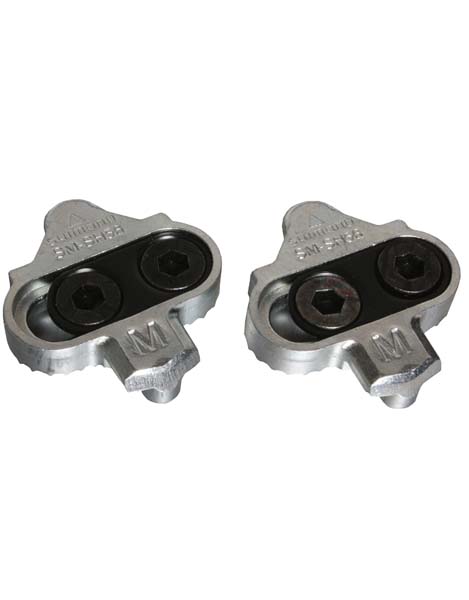
Shimano SPDs are an option to consider when you set up your cleats
Road shoes tend to identify a tighter limit on rearward cleat location than mtb shoes do, and then if yous want to movement your cleats back further than they volition permit, one choice is to switch to mtb or the similar 'sportive'-mode shoes that have ii-bolt SPD-type cleats.
Most people will see no demand to shift their cleats backwards - or forrard - from their current position. Nevertheless, it can be worth checking your cleat position and non just because of a sore Achilles tendon or calf cramps.
Playing around a little with them may help correct an inefficient pedalling activity caused by dropping the heel on the downstroke and may fifty-fifty permit you to produce genuinely useful ankling and with it more power.
Pedalling manner
Plantar flexion: good
Plantar flexion, or pushing downward the forefoot during the down-stroke, tin can contribute to a 'rounder' pedalling activeness although that does non necessarily result in increased power. In many cases although the foot appears plantarflexed, the ankle remains almost immobile and the lower leg muscles merely stabilise the ankle.
Excessive plantar flexion: bad
Some people may find pedalling merely feels 'easier' when dropping their heel during the downwardly-stroke as it reduces the awareness of resistance in the pedals. Dropping your heel tin also be a sign of incorrect bike fit, if your saddle is besides low you lot may drop the heel in an attempt to find a more efficient leg extension.
Ball of foot: good
A location for the cleats in the region of the brawl of your foot allows the calves to do simply the correct amount of work. Variations in foot proportion such as the relative lengths of the big toe and overall pes length may require some aligning and so that the cleat is placed near the ball of the foot without being too far backward or forward.
Mid-foot: bad
Moving the cleats dorsum along the shoe sole to reduce the length of the forefoot lever arm reduces the muscular effort required and makes pedalling less demanding. Just this is not a recommended exercise, equally the human foot tin't contribute to the generation of ability or to the fluidity of the stroke.
How To Add Cleats To Bike Shoes,
Source: https://www.cyclingweekly.com/fitness/bike-fit/cleats-explained-how-to-set-them-up-correctly-23575
Posted by: kellsknours00.blogspot.com


0 Response to "How To Add Cleats To Bike Shoes"
Post a Comment